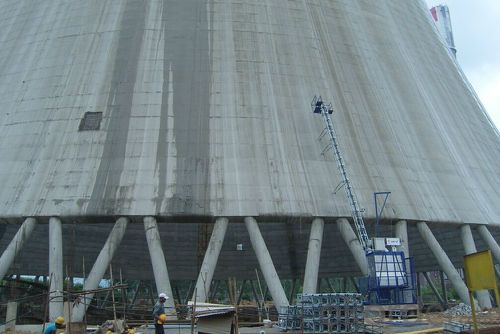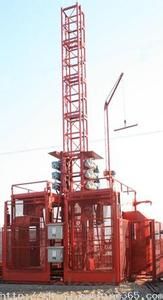Curved Building Hoist SC100/100
- Loading Port:
- Qingdao
- Payment Terms:
- TT or LC
- Min Order Qty:
- -
- Supply Capability:
- 10 unit/month
OKorder Service Pledge
OKorder Financial Service
You Might Also Like
Description for Passenger Hoist
The construction hoist product produced by CMAX has achieved internationally advanced level in terms of industrial design, control and the drive performance, as well as the operation safety and comfortableness. And CMAX is also making efforts to keep improving the product, as what the construction hoist lifts is not only people and material, but also a kind of social responsibility and service concept…
The new generation SC series of construction hoists adopt modular structure, ergonomic design and advanced manufacturing technology, thus the adaptability and reliability of the product is greatly improved, e.g. the max. lifting height can reach 300 meters. The product adopts multiple patented technologies, reaches advanced level in China, and the market share in domestic market is increasing year by year. The product has also been exported to overseas countries like Russia, Turkmenstan, Vietnam, etc. winning the confidence of customers of both home and abroad
Features of Passenger Hoist
1. The cage drive system is equipped with buffering device, so the cage moves more stable.
2. The ergonomically designed cage interior improves comfortableness.
3. The unique structural design has applied for patent.
4. The typical technologies ensure the malposition difference of the guide rail.
5. The excellent parts in the industry ensures reliable quality of the machine.
6. Precise assembly and accurate drive.
7. Professional solutions for special projects.
8. The complete safety devices ensures reliable control system.
Specification of Passenger Hoist
SC series product also has special design, such as reinforced guide rail with cross-section of 800mm, inclined type, special for cooling tower, etc. All the double cage construction elevator can be changed into single cage type, such as SCD200.
Configuration | Standard type | Frequency conversion | Counterweight type | Export type | |
Rated load | kg | 2000/2000 | 2000/2000 | 2000/2000 | 2000/2000 |
Cage size L×W×H | m | 3×1.3×2.2 | 3×1.3×2.2 | 3×1.3×2.2 | 3×1.3×2.2 |
Passengers | 16/16 | 16/16 | 16/16 | 16/16 | |
Max.lifting height | m | 150 | 300 | 150 | 150 |
Max.height of free end | m | 9 | 9 | 9 | 9 |
Lifting speed | m/min | 33 | 0~60 | 33 | 33 |
Capacity of small hoist | kg | 200 | 200 | 200 | 200 |
Std.section L×W×H | mm | 650×650×1508 | |||
The above parameters are subject to change without prior notice, please refer to the actual product.
Note: Both cage size of 3×1.3×2.2 and 3.2×1.5×2.4 are available for of each model (Excl. export type).



FAQ
Q: What is the dimension of the cage?
A: Normally the cage dimension is 3X1.5X2.5M (L/W/H) for 2t type hoist. Details should be checked according to our
quotation sheet. Also, the size can be customized according to the factual site condition. There are two doors (entrance
& exit doors) for each cage, It can be produced as up & down sliding or ramping model for safety and convenience.
Q: What is the Motor u use
A: There are many options for customer. We have China domestic famous brand such as Zhangjiang motor or Baoda Motor. Also customer could choose Germany brand such as Siemens, Schneider, or Nord.
Q:What is Safety Device
A:The safety device is patent product of china. When a cage over-speeds the device should act cut off the power stop the cage on mast gradually. the safety device are adjusted and sealed. Do not disassemble it. The using time limit of safety device are signed on it’s nameplate. Safety device must be delivered to the factory and inspected after it reached to
- Q: This question asks for guidance on selecting an appropriate building hoist for construction purposes.
- <p>To choose a suitable building hoist, consider the following: 1) Capacity: Ensure the hoist can handle the weight of materials to be lifted. 2) Construction site conditions: Choose a hoist that fits the site's dimensions and layout. 3) Safety features: Opt for a hoist with safety mechanisms like overload protection and emergency stop. 4) Maintenance: Select a hoist that requires minimal maintenance to reduce downtime. 5) Cost: Compare prices and consider the total cost of ownership, including maintenance and operation. 6) Manufacturer reputation: Choose a reputable manufacturer for quality and after-sales support. 7) Compliance: Ensure the hoist meets local safety regulations and standards. Always consult with a hoist expert or the manufacturer for specific advice tailored to your project's needs.</p>
- Q: Is it possible to use a building hoist to lift objects that are too large to pass through a standard doorway?
- <p>Yes, a building hoist can be used for lifting objects that are too large to fit through a doorway. Building hoists are designed to handle heavy and oversized items, lifting them vertically through small openings or directly from the ground to higher floors. They are particularly useful in construction projects where large materials or equipment need to be moved to upper levels of a building. However, it's important to ensure the hoist is properly installed and operated by trained personnel to maintain safety and avoid damage to the building or the items being lifted.</p>
- Q: What factors should be considered when selecting an appropriate building hoist for a specific construction project?
- <p>Choosing a suitable building hoist involves assessing several factors: the weight capacity required, the frequency of use, the height and number of floors in the building, the size and shape of materials to be lifted, and safety features. Consider the hoist's speed and efficiency, as well as its ease of installation and maintenance. Consult with hoist manufacturers or experts to ensure the hoist meets local safety regulations and fits the project's specific needs. Always prioritize safety, reliability, and compatibility with the construction workflow.</p>
- Q: Does the building height not exceed 40 meters must install the construction elevator?
- There is an elevator quota in the budget quota, but how many floors can be priced?
- Q: Explain how a lifting platform, specifically a building hoist, operates.
- <p>A building hoist, also known as a construction hoist, is a temporary lifting platform used in construction to lift materials and personnel vertically within a building under construction. It operates by using a motor-driven pulley system that runs on guide rails or tracks. The hoist is attached to the building structure and as the building grows, the hoist is extended upwards. The platform is loaded with materials or workers, and the operator controls the ascent or descent through an electrical switch or remote control. Safety features include limit switches to prevent over-travel, safety catches to stop the platform in case of a cable failure, and interlocks to ensure the platform cannot be operated when the doors are open.</p>
- Q: The user is asking if it's possible to use a building hoist, typically used for construction, to lift a car.
- <p>Using a building hoist to lift a car is not recommended. Building hoists are designed for lifting materials and equipment in construction settings, not for vehicles. They may not have the appropriate safety features or load-bearing capacity for a car. Attempting to lift a car with a building hoist could result in damage to the car, the hoist, or even personal injury. For lifting a car, it's best to use a vehicle-specific lift or a hydraulic lift designed for such purposes, ensuring safety and proper support.</p>
- Q: Is it possible to replace an electric control panel with a manual lever in a lifting system?
- <p>While it is theoretically possible to use a manual lever as a substitute for an electric control panel in a lifting system, it is not advisable. Manual levers lack the precision, safety features, and control capabilities of electric control panels. They also cannot provide the same level of feedback or automation. Electric control panels are designed to ensure safe and efficient operation, with features like emergency stop buttons, overload protection, and remote monitoring. Manual levers can pose safety risks and may not meet the operational requirements of modern lifting systems.</p>
- Q: The construction elevator should have those procedures
- Construction elevator installation unit must have issued by the construction administration department of lifting equipment installation project specialized contracting qualification and construction enterprise safety production license, and within the scope of the qualification licensing business engaged in the installation of construction lifter removed.
- Q: How to adjust the weight limit of the construction elevator
- You're talking about a weight monitor! There are a lot of models and not a good idea.
- Q: This question asks about the safety mechanisms or features that are included in a hydraulic building hoist to ensure its secure operation.
- <p>Hydraulic building hoists are equipped with several safety features to ensure secure operation. These include overload protection to prevent the hoist from lifting more weight than it is designed for, emergency stop buttons for immediate cessation of operations, safety hooks or shackles to secure the load, and lower limit switches to prevent over-lowering. Additionally, they often have a fail-safe valve system that locks the hoist in place if pressure is lost, and a cage or gate to protect operators from falling objects. Regular maintenance and inspection are also crucial for maintaining the safety of these hoists.</p>
Send your message to us
Curved Building Hoist SC100/100
- Loading Port:
- Qingdao
- Payment Terms:
- TT or LC
- Min Order Qty:
- -
- Supply Capability:
- 10 unit/month
OKorder Service Pledge
OKorder Financial Service
Similar products
Hot products
Hot Searches
Related keywords




































